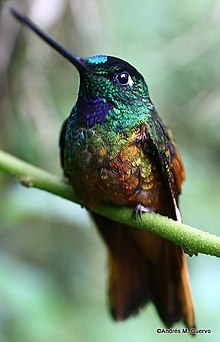Golden-bellied starfrontlet
| Golden-bellied starfrontlet | |
|---|---|

| |
| Scientific classification | |
| Kingdom: | Animalia |
| Phylum: | Chordata |
| Class: | Aves |
| Order: | Apodiformes |
| Family: | Trochilidae |
| Genus: | Coeligena |
| Species: | C. bonapartei
|
| Binomial name | |
| Coeligena bonapartei Boissonneau, 1840
| |

| |
| Synonyms | |
| |
The golden-bellied starfrontlet (Coeligena bonapartei) is a species of hummingbird. The scientific name commemorates Charles Lucien Bonaparte.[2]
Distribution[]
This species can be found in Colombia and a small part of Venezuela.[1][3]
Habitat[]
Its habitat is subtropical or tropical moist montane forests.[1] It follows a habitual path or "trap-line" with stops at flowering plants such as Bomarea, Cavendishia, Fuchsia, , Mutisia, and , whose nectar it feeds on. It also catches insects in flight and gleans them off plants. In general its behavior is probably similar to that of the golden starfrontlet, which may be a subspecies of this species.[3][4]
Description[]

It averages 11.4 centimetres (4.5 in) in length, plus its very long bill (3.3 centimetres (1.3 in)), and 6.5 grams (0.23 oz) in weight. The adult male's crown is blackish with a glittery green patch over the bill (a "frontlet"). Its back is golden-green with a greenish-copper rump. A rufous-buff patch on the tertial wing feathers is conspicuous in flight. The breast glitters green, as does the throat except for a small violet patch in the center. The belly, coppery to reddish gold, glitters intensely. The tail is bronze-green and slightly forked.[3]
The adult female is similar but duller; the green patch over the bill is matte, the throat is plain buff, and the breast is buff with many green spots. The female also lacks the tertial patch.[3]
References[]
- ^ a b c BirdLife International (2016). "Coeligena bonapartei". IUCN Red List of Threatened Species. 2016: e.T61172969A95165329. doi:10.2305/IUCN.UK.2016-3.RLTS.T61172969A95165329.en. Retrieved 16 November 2021.
- ^ Beolen, Bo; Watkins, Michael (2004). Whose Bird? Common Bird Names and the People They Commemorate. Yale University Press. p. 49. ISBN 0-300-10359-X.
- ^ a b c d Hilty, Steven L. (2003). Birds of Venezuela. Princeton University Press. p. 425. ISBN 0-691-09250-8.
- ^ Stiles, Gary (November 2004). "Split Coeligena eos from Coeligena bonapartei". Archived from the original on 2006-09-04. Retrieved 2007-10-04.
- IUCN Red List least concern species
- Coeligena
- Birds of the Colombian Andes
- Birds described in 1840
- Hummingbird stubs
